contents area
Press Release
detail content area
- Date2020-03-26 19:56
- Update2020-06-15 14:48
- DivisionDivision of Risk assessment and International cooperation
- Tel043-719-7556
Updates on COVID-19 in Republic of Korea
26 March 2020
○ As of 0:00, 26 March 2020, a total of 9,241 cases (including 284 imported cases) have been confirmed, of which 4,144 cases have been discharged from isolation. Newly confirmed cases are 104 in total.
[Table 1. Total confirmed and suspected cases]
|
Period (since 3 Jan) |
Total |
Tested positive |
Being tested |
Tested negative |
|||
|
Confirmed |
Discharged |
Isolated |
Deceased |
||||
|
As of 0:00 25 March (Wed) |
357,896 |
9,137 |
3,730 |
5,281 |
126 |
14,278 |
334,481 |
|
As of 0:00 26 March (Thurs) |
364,942 |
9,241 |
4,144 |
4,966 |
131 |
14,369 |
341,332 |
|
Difference |
7,046 |
104 |
414 |
-315 |
5 |
91 |
6,851 |
○ Epidemiological links have been found for 82.2% of the total cases; 14.7% are either under investigation or sporadic cases. More details on the epidemiological links within each province or city are shown in Table 2.
○ From the call center building in Guro-gu, Seoul, 2 additional cases were confirmed. The current total is 160 confirmed cases since 8 March. Of the 160 confirmed cases, 97 are persons who worked in the building (11th floor = 94; 10th floor = 2; 9th floor = 1), and 63 are their contacts.
○ From a preschool in Siheung-si, Gyeonggi Province, one teacher was confirmed with COVID-19. The 48 contacts (children = 33; teachers = 14; parent = 1) of the teacher have been tested, all of which returned negative.
○ In Daegu, testing has been completed for every person at high-risk facilities. Of the 33,256 test results, 224 (0.7%) were positive results.
○ From a healthcare institution (Daegu Fatima Hospital) in Daegu, 19 cases (patients = 10; staff = 5; guardians/caregivers = 4) have been confirmed since 17 March. Most of the confirmed cases arose from the hospital’s 71st and 72nd wings. They have been placed in cohort isolation.
○ In light of the rise in the percentage of imported cases, screening at port entry and strict self-quarantine monitoring is important.
○ Since 22 March, every inbound traveler from Europe is required to be tested. Also, in light of the recent surge in COVID-19 cases in the United States and the rise in the number of imported cases from the US, starting 0:00 of 27 March, a stronger screening process will be applied for inbound travelers from the United States.
- All symptomatic persons entering from the US, regardless of nationality, will be required to wait for testing in a facility within the airport. Persons who test positive will be transferred to a hospital or “Life Treatment Center”. Persons who test negative will enter self-quarantine at home for 14 days.
- Korean nationals and foreigners with a domestic residence who are asymptomatic at the time of entry will enter self-quarantine in their home for 14 days and get tested if symptoms begin to occur.
- Foreigners who are on a short-term visit without domestic residence and thus are unable to self-quarantine will be tested in at a temporary facility. If they test negative, they will be allowed entry under enhanced active monitoring. Those subject to self-quarantine are required to install the self health check app on their phone and report their symptoms on the app. The authorities will consider whether to begin requiring every inbound traveler from the U.S. to be tested if it becomes necessary in the future, based on whether the situation worsens in regards to COVID-19 transmission in the United States and the number of imported cases from the U.S.
○ The KCDC urged all inbound travelers to follow the precautionary measures, including not leaving home for 14 days, minimizing contact with other people, not going to work, washing hands, covering sneezes and coughs.
- Any person who suspect onset of COVID-19 symptoms are advised to call the KCDC call center (1339) or local call centers (area code + 120), ask a local public health center, or visit a screening facility, before visiting a regular healthcare provider directly. All persons who visit a screening center should arrive wearing a mask and in their own car if possible, and disclose their international travel history to the healthcare professionals.
- The KCDC also advised employers to ensure that employees returning from international business trips will not return to their office for the first 2 weeks upon their return. In particular, employers should especially ensure that employees working at publicly used venues who have international travel history are required to work from home or take a short leave.
○ The KCDC, Ministry of Land, Infrastructure and Transport, and Ministry of Science and ICT begin the official launch of “COVID-19 Epidemiological Investigation Support System”, which is a system to automate epidemiological investigation in accordance with the Infectious Disease Control and Prevention Act.
○ In light of the continued emergence of outbreaks in various venues such as religious facilities and workplaces, the KCDC urged everyone to participate in enhanced social distancing campaign for 15 days (22 March – 5 April). Citizens are advised to stay home as much as possible other than for going to work, visiting a healthcare provider, and purchasing necessities. Working citizens are asked to maintain a distance from other people during lunch breaks, refrain from using break rooms and other social venues, and pay closer attention to maintaining personal hygiene (e.g. washing hands).
- Employers are advised to implement various methods of minimizing person-to-person contact for employees, such as reorganizing workspaces to ensure greater distancing and implementing work-from-home and flexible hours systems. Those who show symptoms should be advised not to show up at work. Workers who develop symptoms mid-day should be sent home immediately. The government has also limited the operation of high-risk facilities including religious facilities, some indoor fitness facilities, and nightlife venues. Venues that remain in operation must strictly comply with infection prevention guidelines (e.g. disinfecting, ventilation, distancing, mask wearing) set by the authorities.
[Table 2. Regional distribution and epidemiological links of the confirmed cases]
|
Region |
Confirmed cases |
Other major clusters |
||||||||
|
Total |
Imported cases |
Clusters |
Other* |
New cases |
||||||
|
Sub- total |
Shin- cheonji |
Small clusters |
Contacts of confirmed cases |
Imported cases |
||||||
|
Seoul |
360 |
68 |
266 |
7 |
197 |
37 |
25 |
26 |
13 |
Guro-gu call center (96), Dongan Church-PC Cafe (20), etc. |
|
Busan |
112 |
2 |
76 |
11 |
49 |
16 |
0 |
34 |
0 |
Onchun Church (32), Suyeong-gu Kindergarten (5), etc. |
|
Daegu |
6,482 |
2 |
5,463 |
4,391 |
347 |
725 |
0 |
1,017 |
26 |
Hansarang Convalescent Hospital (101), Daesil Convalescent Hospital (78), KimSin Recuperation Hospital (32), Daegu Fatima Hospital (19), etc. |
|
Incheon |
43 |
7 |
34 |
2 |
27 |
3 |
2 |
2 |
1 |
Guro-gu call center (20), etc. |
|
Gwangju |
19 |
4 |
14 |
9 |
0 |
2 |
3 |
1 |
0 |
|
|
Daejeon |
30 |
1 |
18 |
2 |
10 |
6 |
0 |
11 |
6 |
Korea Forest Engineer Institute (3), etc. |
|
Ulsan |
37 |
6 |
24 |
16 |
1 |
4 |
3 |
7 |
0 |
|
|
Sejong |
44 |
0 |
42 |
1 |
38 |
3 |
0 |
2 |
0 |
Ministry of Oceans and Fisheries (29), gym facilities (8) |
|
Gyeonggi |
401 |
47 |
309 |
29 |
210 |
57 |
13 |
45 |
14 |
Grace River Church in Seongnam (68), Guro-gu call center-Bucheon SaengMyeongSu Church (44), etc. |
|
Gangwon |
31 |
2 |
22 |
17 |
5 |
0 |
0 |
7 |
0 |
Apartments in Wonju City (3), etc. |
|
Chung- |
39 |
0 |
26 |
6 |
11 |
9 |
0 |
13 |
1 |
Goesan-gun Jangyeon-myeon (11) |
|
Chung- |
124 |
5 |
112 |
0 |
112 |
0 |
0 |
7 |
1 |
Gym facilities in Cheonan (103), research center in Seosan (8), etc. |
|
Jeon- buk |
10 |
3 |
1 |
1 |
0 |
0 |
0 |
6 |
0 |
|
|
Jeon- |
8 |
1 |
4 |
1 |
0 |
2 |
1 |
3 |
0 |
|
|
Gyeong- |
1274 |
1 |
1,115 |
554 |
388 |
172 |
1 |
158 |
12 |
Cheongdo Daenam Hospital (120), Bonghwa Pureun Nursing Home (68), pilgrimage to Israel (49), Gyeongsan Seorin Nursing Home (36), etc. |
|
Gyeong- |
90 |
2 |
72 |
32 |
35 |
5 |
0 |
16 |
0 |
Geochang Church (10), Geochang Woongyang-myeon (8), etc. |
|
Jeju |
6 |
2 |
0 |
0 |
0 |
0 |
0 |
4 |
0 |
|
|
Airport |
131 |
131 |
0 |
0 |
0 |
0 |
0 |
0 |
30 |
|
|
Total |
9241 |
284 |
7,598 |
5,079 |
1,430 |
1,041 |
48 |
1,359 |
104 |
|
|
(3.1%) |
(82.2%) |
(55.0%) |
(15.5%) |
(11.3%) |
(0.5%) |
(14.7%) |
||||
|
* Not classified into a cluster or under investigation ※ The interim classification is based on the reporting location, which may change depending on further epidemiological investigation. |
||||||||||
○ Case distribution data:
[Table 3. Confirmed cases by region]
|
|
Total |
City |
||||||||||||||||||||||||||||||||||||||||||||||||||||||||||||||||||||||||||||||||||||||||||||||||||||||||
|
Seoul |
Busan |
Daegu |
Incheon |
Gwangju |
Daejeon |
Ulsan |
Sejong |
|||||||||||||||||||||||||||||||||||||||||||||||||||||||||||||||||||||||||||||||||||||||||||||||||||
|
Isolated |
4,966 |
280 |
35 |
3,349 |
32 |
8 |
24 |
17 |
36 |
|||||||||||||||||||||||||||||||||||||||||||||||||||||||||||||||||||||||||||||||||||||||||||||||||
|
Discharged |
4,144 |
80 |
75 |
3,039 |
11 |
11 |
6 |
20 |
8 |
|||||||||||||||||||||||||||||||||||||||||||||||||||||||||||||||||||||||||||||||||||||||||||||||||
|
Deceased |
131 |
0 |
2 |
94 |
0 |
0 |
0 |
0 |
0 |
|||||||||||||||||||||||||||||||||||||||||||||||||||||||||||||||||||||||||||||||||||||||||||||||||
|
Subtotal |
9,241 |
360 |
112 |
6,482 |
43 |
19 |
30 |
37 |
44 |
|||||||||||||||||||||||||||||||||||||||||||||||||||||||||||||||||||||||||||||||||||||||||||||||||
|
(Change) |
(104) |
(13) |
- |
(26) |
(1) |
- |
(6) |
- |
- |
|||||||||||||||||||||||||||||||||||||||||||||||||||||||||||||||||||||||||||||||||||||||||||||||||
|
|
Province |
Other |
||||||||||||||||||||||||||||||||||||||||||||||||||||||||||||||||||||||||||||||||||||||||||||||||||||||||
|
Gyeonggi |
Gangwon |
Chung-buk |
Chung- nam |
Jeon- buk |
Jeon- nam |
Gyeong- buk |
Gyeong-nam |
Jeju |
Airport screening |
|||||||||||||||||||||||||||||||||||||||||||||||||||||||||||||||||||||||||||||||||||||||||||||||||
|
Isolated |
275 |
12 |
25 |
56 |
3 |
5 |
643 |
33 |
2 |
131 |
||||||||||||||||||||||||||||||||||||||||||||||||||||||||||||||||||||||||||||||||||||||||||||||||
|
Discharged |
122 |
18 |
14 |
68 |
7 |
3 |
601 |
57 |
4 |
0 |
||||||||||||||||||||||||||||||||||||||||||||||||||||||||||||||||||||||||||||||||||||||||||||||||
|
Deceased |
4 |
1 |
0 |
0 |
0 |
0 |
30 |
0 |
0 |
0 |
||||||||||||||||||||||||||||||||||||||||||||||||||||||||||||||||||||||||||||||||||||||||||||||||
|
Subtotal |
401 |
31 |
39 |
124 |
10 |
8 |
1,274 |
90 |
6 |
131 |
||||||||||||||||||||||||||||||||||||||||||||||||||||||||||||||||||||||||||||||||||||||||||||||||
|
(Change) |
(14) |
- |
(1) |
(1) |
- |
- |
(12) |
- |
- |
(30) |
||||||||||||||||||||||||||||||||||||||||||||||||||||||||||||||||||||||||||||||||||||||||||||||||
|
[Table 4. Case distribution and incidence rate by region]
[Figures 1-4. Daily case trends by region] |
||||||||||||||||||||||||||||||||||||||||||||||||||||||||||||||||||||||||||||||||||||||||||||||||||||||||||

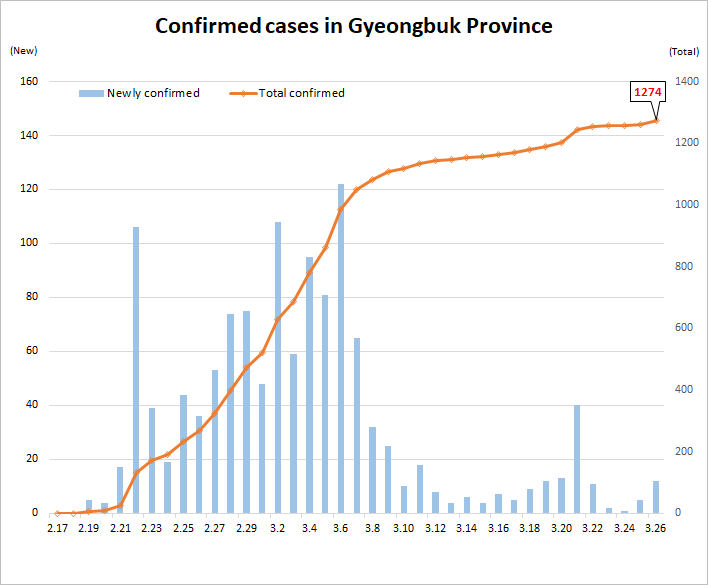
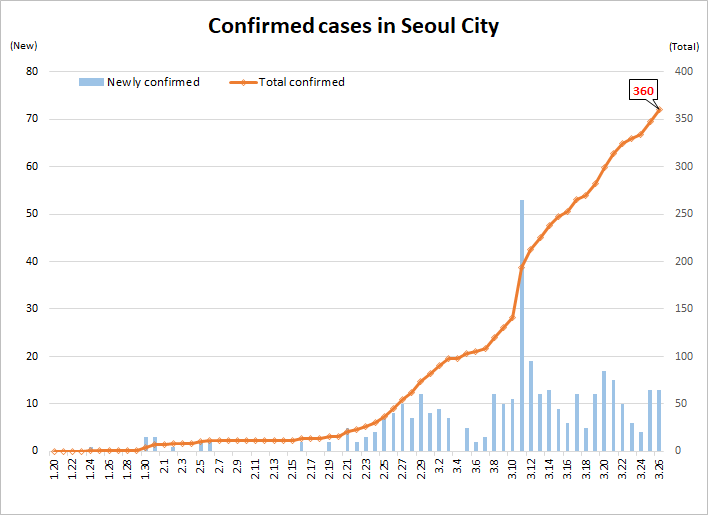
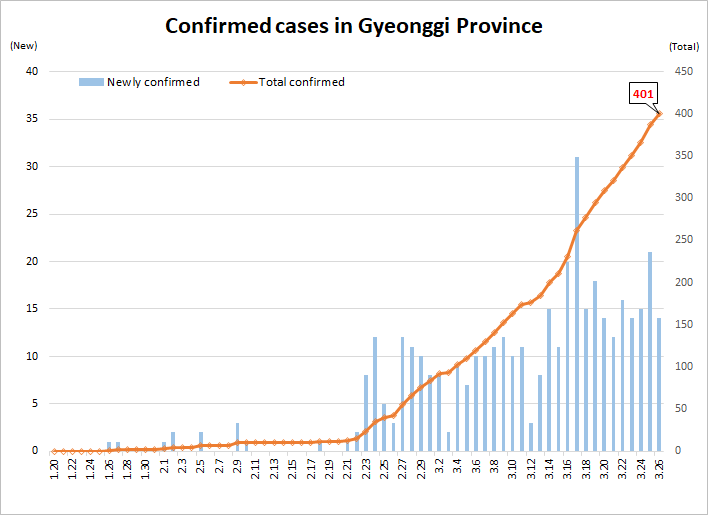
[Table 5. Case distribution by gender and age group]
|
|
Confirmed Cases |
(%) |
Deaths |
(%) |
Fatality rate (%) |
|
|
Total |
9,241 |
(100) |
131 |
(100) |
1.42 |
|
|
Sex |
Male |
3,598 |
(38.94) |
68 |
(51.91) |
1.89 |
|
Female |
5,643 |
(61.06) |
63 |
(48.09) |
1.12 |
|
|
Age |
80 and above |
416 |
(4.50) |
58 |
(44.27) |
13.94 |
|
70-79 |
616 |
(6.67) |
41 |
(31.30) |
6.66 |
|
|
60-69 |
1,162 |
(12.57) |
20 |
(15.27) |
1.72 |
|
|
50-59 |
1,738 |
(18.81) |
10 |
(7.63) |
0.58 |
|
|
40-49 |
1,252 |
(13.55) |
1 |
(0.76) |
0.08 |
|
|
30-39 |
955 |
(10.33) |
1 |
(0.76) |
0.10 |
|
|
20-29 |
2,508 |
(27.14) |
0 |
(0.00) |
- |
|
|
10-19 |
488 |
(5.28) |
0 |
(0.00) |
- |
|
|
0-9 |
106 |
(1.15) |
0 |
(0.00) |
- |
|
[Figures 5-6. Case distribution by gender and age group]
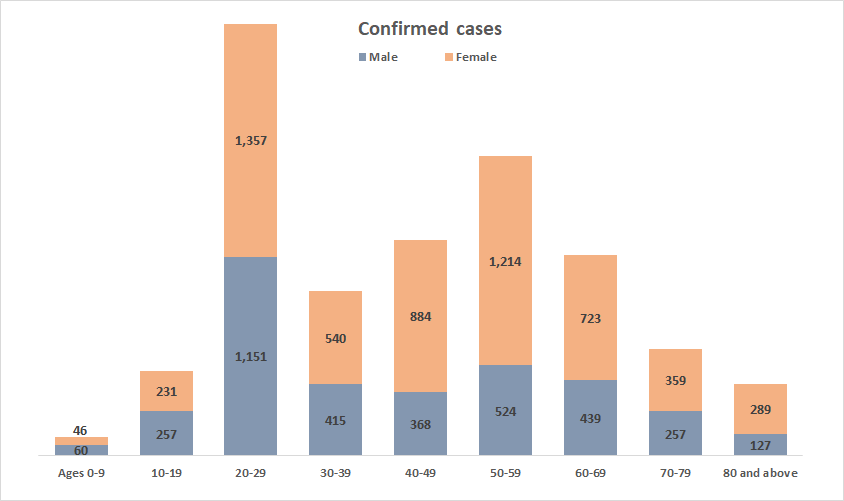

[Figure 7. Weekly trend of imported cases]
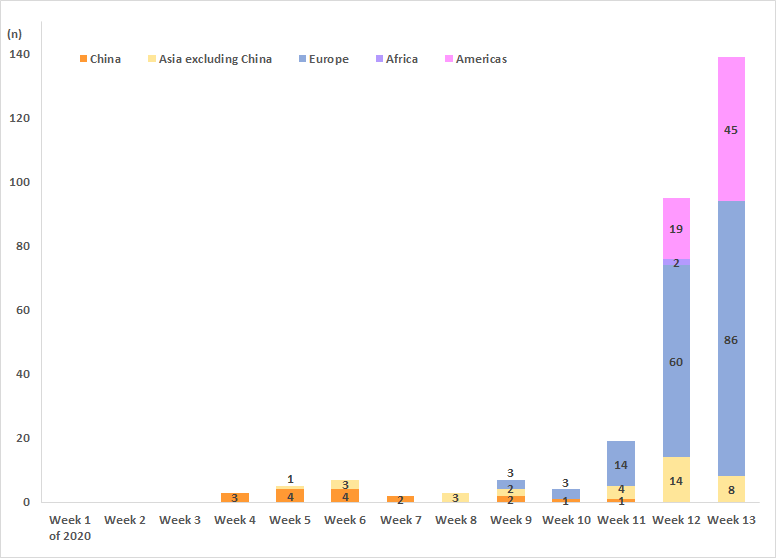
 This public work may be used under the terms of the public interest source + commercial use prohibition + nonrepudiation conditions
This public work may be used under the terms of the public interest source + commercial use prohibition + nonrepudiation conditions